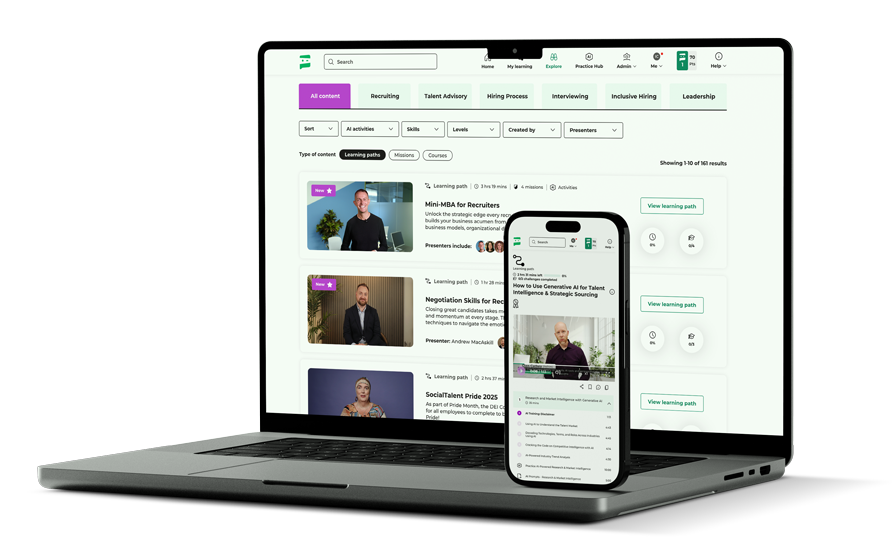10 Ways Recruiters can be Better LGBTQ+ Allies During the Hiring Process
Inclusivity isn’t just a buzzword – it’s a crucial component of a thriving, dynamic workplace. As the world becomes more aware of the diverse spectrum of human identities and experiences, the role of recruiters in championing LGBTQ+ inclusion has never been more critical. An inclusive hiring process not only attracts top talent from all walks of life but also fosters innovation, creativity, and a sense of belonging within the company.
Recruiters, often the first point of contact for potential employees, have a unique opportunity to set the tone for inclusivity from the very beginning. By being effective allies to the LGBTQ+ community, recruiters can help build workplaces where everyone feels valued and respected, regardless of their sexual orientation or gender identity. This commitment to inclusivity is not only the right thing to do but also enhances the company’s reputation, employee satisfaction, and overall success.
Here are 10 actionable ways recruiters can become better LGBTQ+ allies throughout the hiring process, ensuring that their practices not only attract but also support diverse talent.

1. Educate Yourself and Your Team
Did you know that almost half of LGBTQ+ employees in America remain closeted in the workplace? Understanding the challenges and experiences of LGBTQ+ individuals is the first step in becoming an ally. Invest time in learning about LGBTQ+ issues, terminology, and the legal protections in place. Consider attending workshops, webinars, or sensitivity training programs. And encourage your team to do the same – fostering a culture of continuous learning and awareness is crucial when it comes to being an effective ally.
As Joanne Lockwood, SocialTalent’s LGBTQ+ recruiting expert, says in her training:
“Think about how you frame your process. Does it appeal to me? Am I welcomed? Are people expecting someone who is not traditional? Sometimes recruitment methods do discriminate. Often though, it’s not deliberate, it’s inadvertent through lack of planning and lack of thought.”
Learn more: 9 Types of Bias and the Ways they Affect Your Recruiting Efforts
2. Use Inclusive Language in Job Descriptions
Language plays a critical role in making job descriptions more inclusive. Avoid gender-specific pronouns and phrases that may alienate LGBTQ+ candidates. Instead of “he/she,” use “they” or “the candidate.” It is also a good idea to highlight your company’s commitment to diversity and inclusion explicitly in the job posting to attract a broader range of applicants.
Learn more: How to Write Inclusive Job Descriptions
3. Review and Update Your Hiring Policies
Ensure your hiring policies are inclusive and non-discriminatory. This includes having a clear anti-discrimination policy that explicitly mentions sexual orientation and gender identity. Regularly review these policies to ensure they align with best practices and current legal standards. Implementing such policies sends a strong message about your commitment to inclusivity.
4. Create a Safe and Inclusive Interview Environment
Interviews can be stressful, especially for LGBTQ+ candidates who may worry about bias or discrimination. In fact, according to UCLA research, over 50% of LGBTQ+ employees have experienced discrimination in the workplace. To create a safe space:
- Ensure all interviewers are trained on diversity and inclusion.
- Avoid questions that may reveal a candidate’s sexual orientation or gender identity.
- Respect preferred names and pronouns. If unsure, ask politely or proffer your own to show that you are an ally and understand.
- Offer the option for virtual interviews to provide more flexibility.
5. Showcase Your Company’s LGBTQ+ Inclusion Efforts
Candidates want to see that your commitment to inclusivity is genuine. Highlight your company’s LGBTQ+ initiatives on your website and social media channels. Share stories of LGBTQ+ employees, promote your participation in LGBTQ+ events, and showcase any partnerships with LGBTQ+ organizations. This visibility can reassure candidates that they will be valued and supported.
6. Ensure Equitable Compensation and Benefits
Equity in compensation and benefits is crucial for fostering an inclusive workplace. Ensure that your company offers benefits that are inclusive of LGBTQ+ employees, such as:
- Health insurance that covers gender-affirming care.
- Family leave policies that are inclusive of all family structures.
- Partner benefits that extend to same-sex couples. Regularly review your compensation practices to identify and rectify any disparities.
According to an Indeed report, however, while 57% of employees believe having LGBTQ+ specific benefits is important, only 23% of organizations offer them.
7. Implement Blind Hiring Practices
Consider adopting blind hiring practices to help reduce unconscious bias in the hiring process. By removing identifying information such as names, pronouns, and photos from applications, you can focus on the candidate’s skills and experience. This practice promotes a more equitable evaluation process and can help increase the diversity of your hires.
8. Provide Supportive Onboarding and Mentorship Programs
A supportive onboarding process is essential for making new hires feel welcome. Ensure that your onboarding materials and processes are inclusive and reflect your commitment to diversity. Pair new LGBTQ+ employees with mentors who can provide guidance and support as they navigate the company culture. And don’t forget to make all new employees aware of any ERGs that may be available to join.
Learn more: How to Create an Onboarding Experience that Really Works
9. Solicit and Act on Feedback
Regularly solicit feedback from your employees, including LGBTQ+ staff, about their experiences in the hiring process and workplace. Use anonymous surveys with targeted questions to encourage honest feedback. Act on the insights gained to continuously improve your practices and address any areas of concern.
10. Advocate for LGBTQ+ Rights Beyond the Workplace
Being an ally means advocating for LGBTQ+ rights beyond your company’s walls. Support local and national LGBTQ+ organizations, participate in advocacy efforts, and encourage your company to take a stand on important issues. Your advocacy can have a significant impact and demonstrate your company’s commitment to inclusivity.
Conclusion
Being a better LGBTQ+ ally in the hiring process requires ongoing effort, education, and commitment. By implementing these strategies, recruiters can help create a more inclusive and equitable hiring process that benefits everyone. Remember, inclusivity is not just a policy – it’s a practice that needs to be woven into the fabric of your company culture. Through these actions, you can contribute to a workplace where every individual, regardless of their sexual orientation or gender identity, feels respected and valued.


